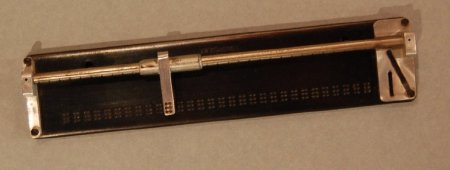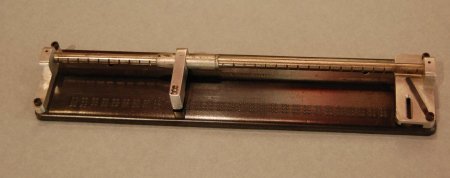Object ID:
1992.33
Title:
Hoff Aid
Creator:
Hoff, Paul
Description:
Stamped steel slate has one line of 30 cells; bright steel rod with spiral groove at 1/4 inch intervals; movable die-box fitted with six inverted, conically shaped caps the size of the braille dots on the dark steel base; bright steel paper holder fits into the left side of the slate; stylus is used on the die-box to depress the caps to form braille dots; stamped on base, "AMERICAN PRINTING HOUSE FOR THE BLIND/LOUISVILLE, KY".
Dimensions:
H-0.875 W-9.375 D-2.125 inches
Date:
ca. 1955
Made by:
American Printing House for the Blind.
Place of Origin:
Louisville, KY
Provenance:
The Hoff Aid was an upward-writing slate designed primarily for use in making mathematical calculations on paper. It permitted examination of the brailled characters without having to remove the paper from the slate. Paul Hoff, a teacher at the Minnesota Braille and Sight Saving School, filed a patent application for his aid in 1946, seeing it as a compromise between the light weight and portability of a pocket slate, and the right-to-left upward writing capability of the braillewriter. It was introduced in the APH catalog in 1955, primarily as a mathematics tool, and discontinued in 1973 after a total production of 538 units. In the end it was determined to be too expensive ($22.50 in 1963) when compared to a slate, and too slow when compared to other math tools such an an abacus.
Credit Line:
APH Collection, 1992.33

